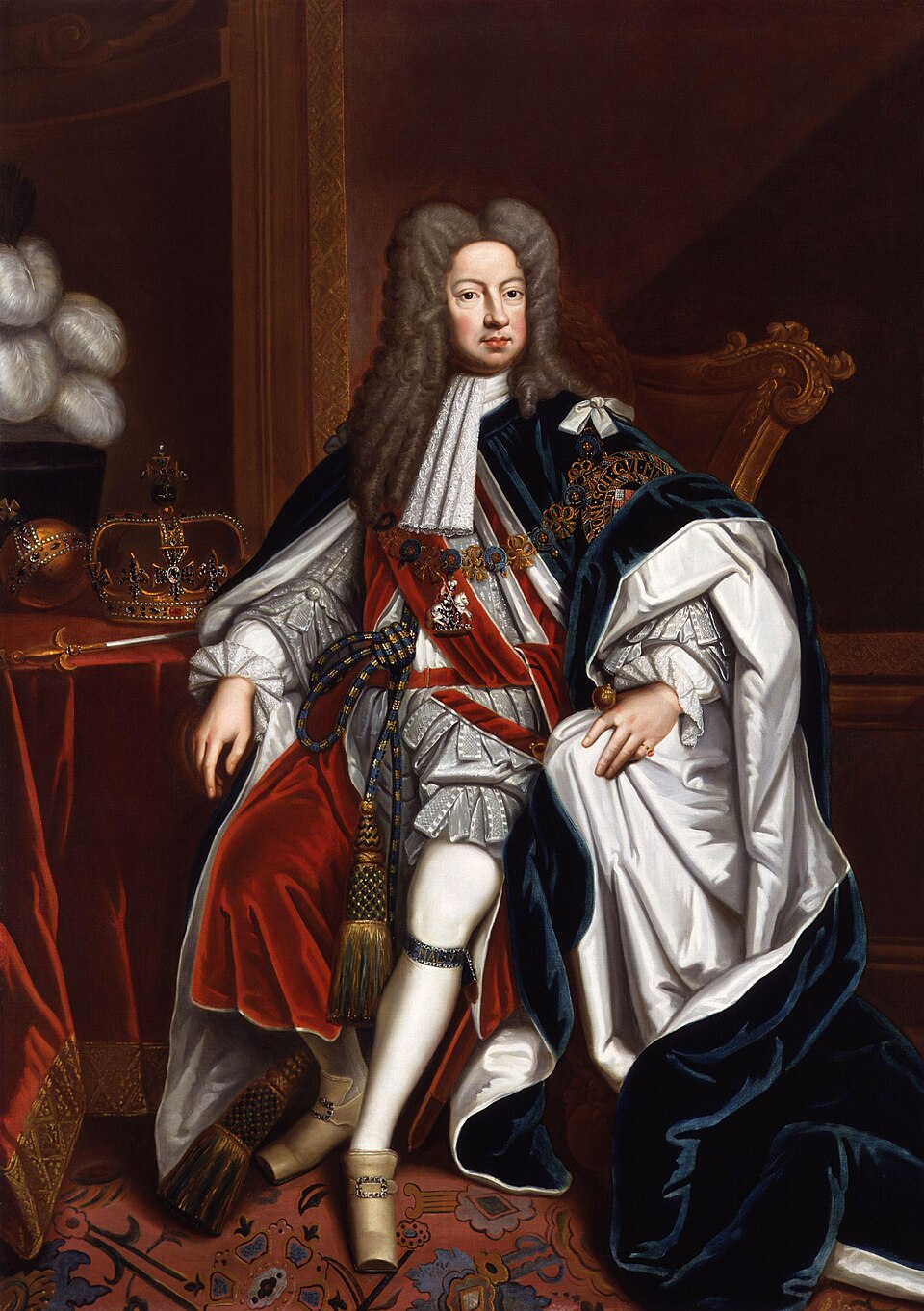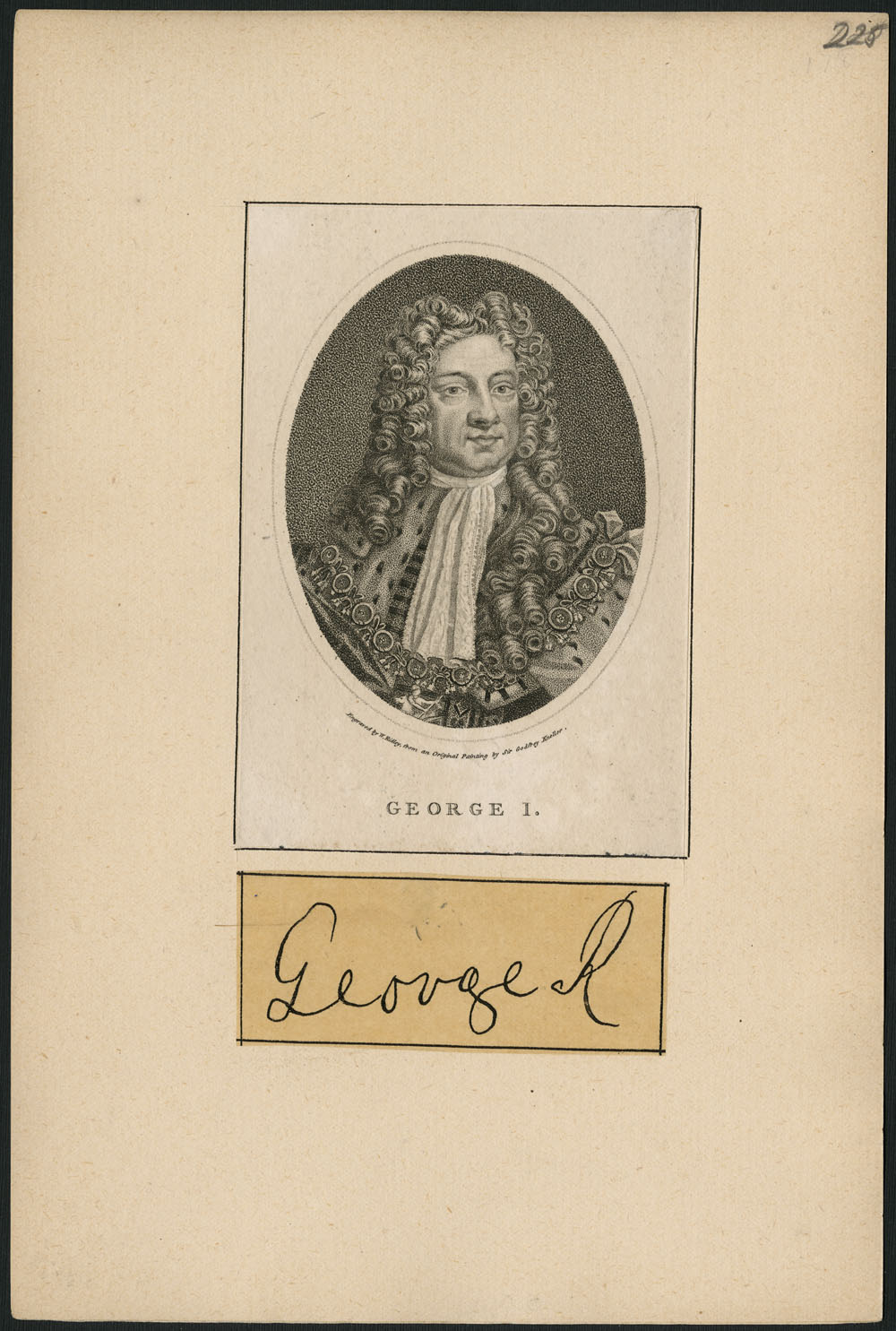George I, elector of Hanover from 1698 to 1727 and king of Great Britain and Ireland from 1714 to 1727 (born 28 May 1660 in Hanover, Germany; died 11 June 1727 in Osnabrück, Germany). George I was the first British monarch from the House of Hanover. Many places in Canada are named after his titles, territories and ancestry.

Parents
George I was born Georg Ludwig (George Louis), the eldest son of the seven surviving children of Ernest Augustus (1629–1698), Duke of Brunswick-Lüneburg and Prince of Calenberg from 1679 to 1698 and elector of Hanover from 1692 to 1698. GeorgLudwig’s mother was Sophia of the Palatinate (1630–1714), a granddaughter of King James I of England (King James VI of Scotland) through her mother, Queen Elizabeth of Bohemia. Sophia was the younger sister of Prince Rupert of the Rhine, first governor of the Hudson’s Bay Company and a cousin once removed of Queen Anne, the last Stuart monarch of Great Britain and Ireland.
Did you know?
Depending on the source, you may see different dates for George I’s birth and death. During his life, Britain used the Julian calendar, but in 1752, it changed to the Gregorian calendar. (See our article on Calendars for more information about this change.) Beginning in the 18th century, some sources provided both the “Old Style” (O.S.) and “New Style” (N.S.) dates for events. In the case of George I, historians usually identify his birthdate as 28 May 1660 (O.S.) but others use 7 June 1660 (N.S.) or both.
Marriage and Children
On 22 November 1682, 22-year-old Georg Ludwig married his 16-year-old cousin Sophia Dorothea of Celle. The marriage united the duchies of Hanover and Celle. They had two children: George Augustus (1683–1760), who became King George II in 1727, and Sophia Dorothea (1687–1757), who married the future King Frederick William I of Prussia in 1706. The marriage of Georg Ludwig and Sophia Dorothea was dissolved in 1694 following the discovery of a relationship between Sophia Dorothea and Swedish count Philipp Christoph von Königsmark, an officer in the Hanoverian army, who was assassinated in 1694. Sophia was imprisoned for the rest of her life in Ahlden Castle in Lower Saxony and never saw her children again.
Georg Ludwig also had three daughters with his mistress, Melusine von der Schulenburg: Anna Luise (1692–1773), Petronilla (1693–1778) and Margarethe Gertrud (1701–1726). Von der Schulenburg accompanied him to Britain when he became King George I in 1714.
Military Career
Georg Ludwig began his military career at the age of 15, serving with his father in the Franco-Dutch War. During the War of the Spanish Succession (1701–1714), Georg Ludwig served as an imperial field marshal in command of the Holy Roman Empire’s forces along the Rhine, allied with the British against the claims to the Spanish throne of King Louis XIV of France’s grandson Philippe, Duke of Anjou. Georg Ludwig resigned as imperial field marshal in 1709, ending his active military service.
The Act of Settlement
In 1701, the English parliament passed the Act of Settlement, which legislated Sophia of Hanover and her Protestant descendants as heirs to the English throne. This legislation was a response to the death of Prince William, Duke of Gloucester — Queen Anne’s only surviving child. His death meant the end of the direct Protestant Stuart line. Sophia and Georg Ludwig were not Anne’s closest living relatives, but the English parliament settled the succession on the House of Hanover to ensure a Protestant royal line in Britain, which continues to the present day. The Acts of Union, passed in 1707, created a single parliament for England and Scotland, ensuring that the same monarch would reign in all of Great Britain.

King George I
Queen Anne died on 1 August 1714, less than two months after Sophia of Hanover. According to the terms of the Act of Settlement, Georg Ludwig, elector of Hanover, became King George I of Great Britain and Ireland. His coronation took place in Westminster Abbey on 20 October 1714. George I was a cultural patron, supporting theatre, opera and classical music, especially the career of composer George Frideric Handel. He spoke little English, however, and was not personally popular. His mistreatment of his former wife, his estrangement from his son and corruption among his ministers, as well as the presence of his illegitimate half-sister, Sophia Charlotte, and mistress Melusine von der Schulenburg at his court, were all topics of political pamphlets and satire. In 1715 and 1719, there were Jacobite uprisings in Scotland in support of the late Queen Anne’s Roman Catholic half-brother, James Edward Stuart, “the Old Pretender” to the British throne.
Constitutional Monarchy
George I’s reign saw important developments in the evolution of the constitutional monarchy. According to the terms of the 1689 Bill of Rights that had been accepted by King William III and Queen Mary II, George I was expected to govern on the advice of his ministers. Sir Robert Walpole, George I’s Chancellor of the Exchequer and First Lord of the Treasury from 1721, emerged as Great Britain’s de facto first prime minister. Party politics, shaped by the rivalry between the Whig and Tory factions, continued to develop over the course of George I’s reign. When George I died of a stroke in 1727, the throne passed peacefully to his son George II, ensuring the future of the Hanoverian succession.
Foreign Policy
George I exercised greater personal influence over British foreign policy than domestic policy, informed by his position as elector of Hanover. He visited Hanover frequently, especially in the later years of his reign, and supported a defensive alliance between Great Britain and Prussia. This alliance was supported by the Prussian dynastic marriages of his daughter Sophia Dorothea and granddaughter Anne, Princess Royal. George I took less interest in Great Britain’s North American colonies, which had expanded to include Newfoundland and Nova Scotia with the Treaty of Utrecht, which ended the War of the Spanish Succession in 1713. George I was concerned with colonial trade revenues, however, and took steps to suppress piracy in North America and the Caribbean. George I was a significant shareholder in the South Sea Company, which was engaged in the trans-Atlantic slave trade, and the King profited from his investments despite the collapse of the South Sea Bubble in 1720.
Legacy in Canada
Many places in central and eastern Canada are named after the titles, lands and ancestry of King George I’s dynasty, the House of Hanover, including the province of New Brunswick; Lunenburg, Nova Scotia; Hanover, Ontario; and Guelph, Ontario. George I’s direct descendant King Charles III is king of the United Kingdom, Canada and 13 other Commonwealth realms. The Act of Settlement, which brought George I to the British throne (updated by the 2013 Succession to the Crown Act), continues to govern the royal succession in the 21st century.

 Share on Facebook
Share on Facebook Share on X
Share on X Share by Email
Share by Email Share on Google Classroom
Share on Google Classroom



